The museum of the dead is at the foot of the fortifications of la Bastille, wedged between the river and the rise of the Chartreuse, sheltered by the old city wall. The museum’s body is that of a church built a thousand years ago (over an older church, and another even older) atop a necropolis dug a thousand years before that.
There are skeletons everywhere.
The name of the museum of the dead is not Musée des Morts, but Musée archéologique Saint-Laurent. It’s an archaelogical dig, with glass walkways snaking in and out and over the excavated sanctum. The exposed earth and stone below are layered liberally with stray femurs and skull fragments. In more favored spots, full skeletons lie arrayed where they were left in graves centuries ago. Drawn in water soluble ink on the glass of windows and partitions there are festive skulls and skeletons, festooned in flowers and bright paint in the style of Dia de Los Muertos. One skeleton’s bony fingers form a jaunty heart to peer through to the graves below.
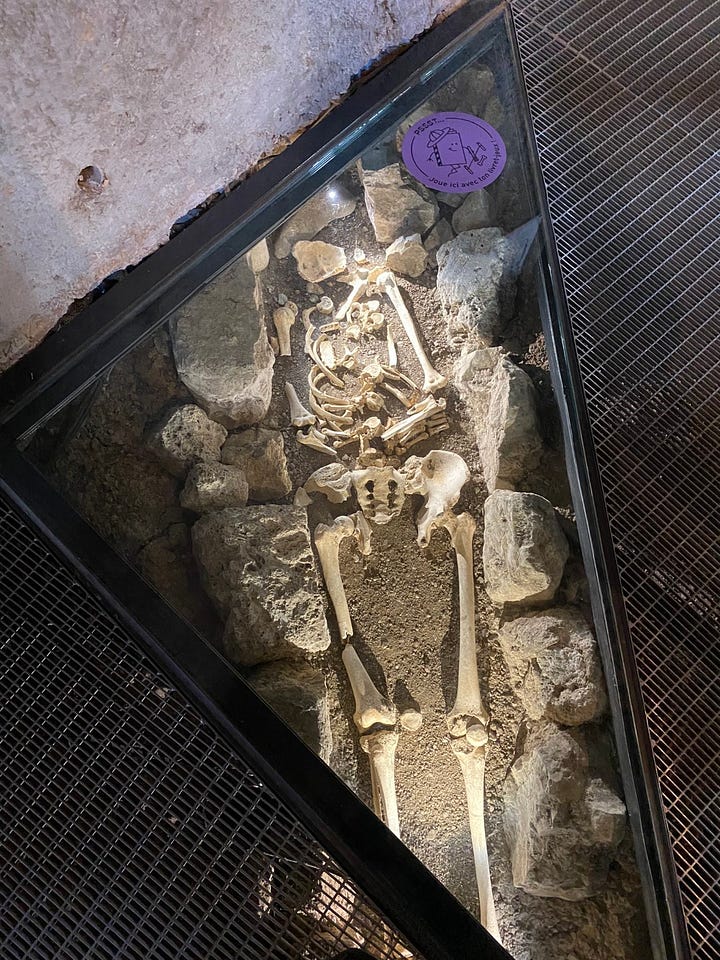

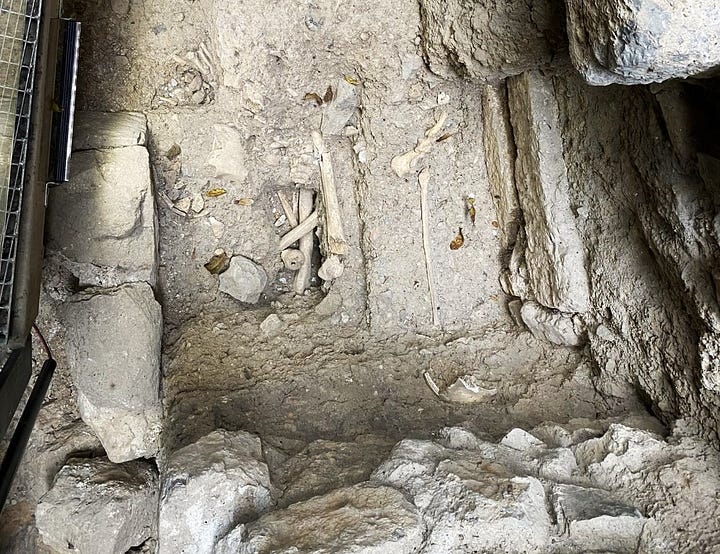

Here, the past ties itself in knots. The great doorway of the Église Saint-Laurent is double-arched: the smaller, younger, 17th-century arch is nested within the partially excavated 12th-century one, which is painted vividly with plaster saints. Nearby, a finely lettered grave marker from the 6th century is slotted sideways among the other stones in the abbey wall, having been repurposed from the necropolis.1
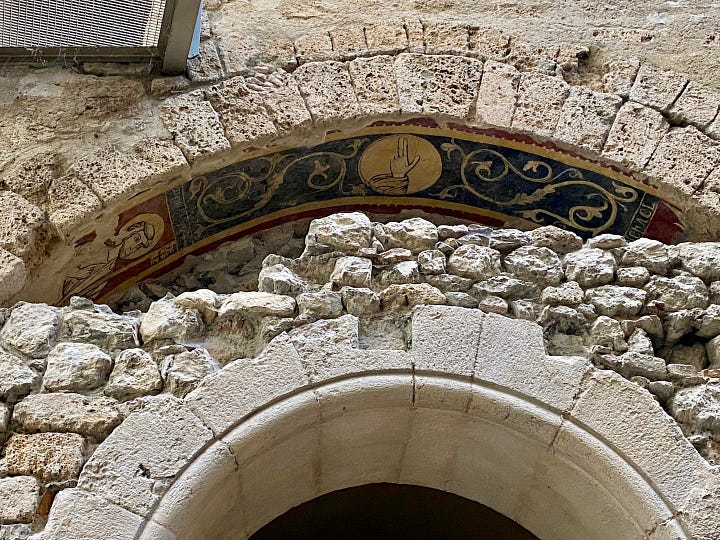

Inside the high-ceilinged chapel, the wall and ceiling borders are painted in Art Nouveau2 rainbow hues, adorned with innocent swastikas (from 1910). The floor of the nave is gone, chipped and dug down to the walls and foundations of earlier churches’ crypts and their stone sepulchers standing empty. Only the chancel and sanctuary floor around the 18th-century altar, under the intensely decorated dome of the apse and its 19th-century stained glass, remain as they were last arranged in the consecrated life of the church.
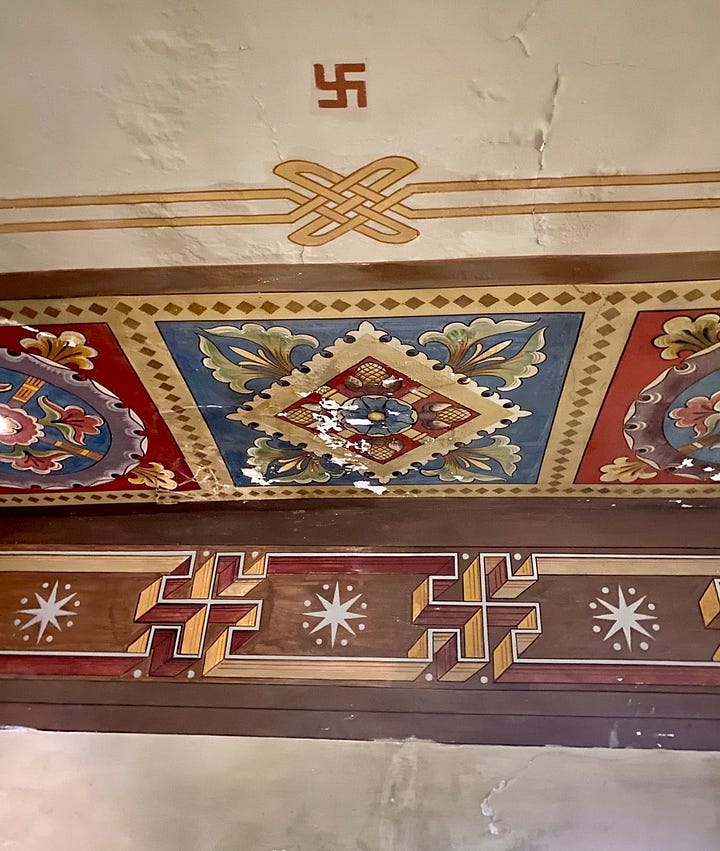
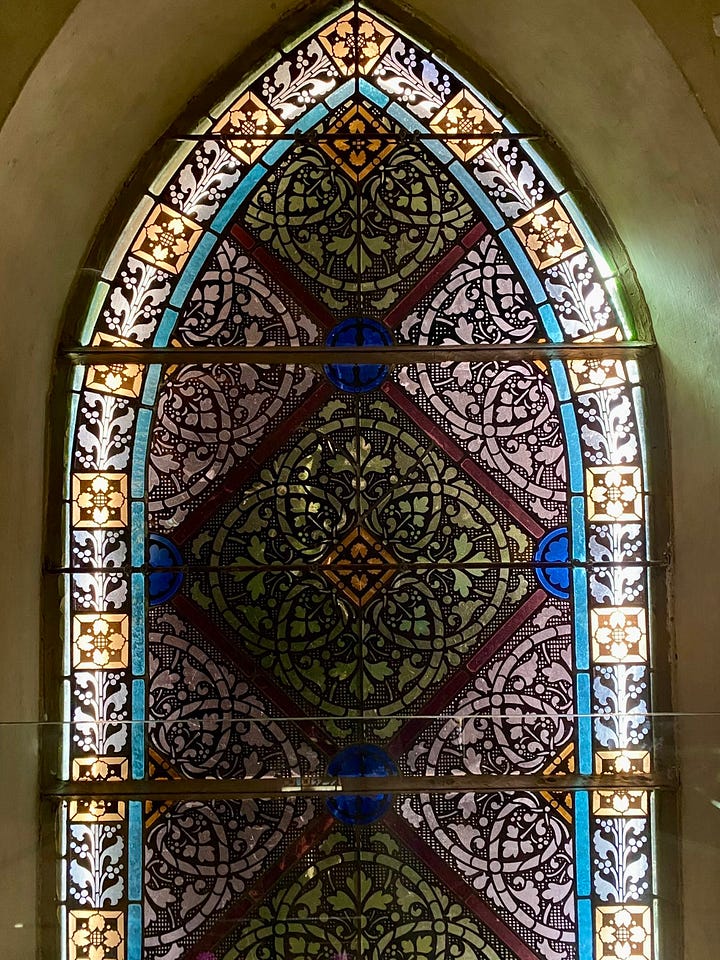

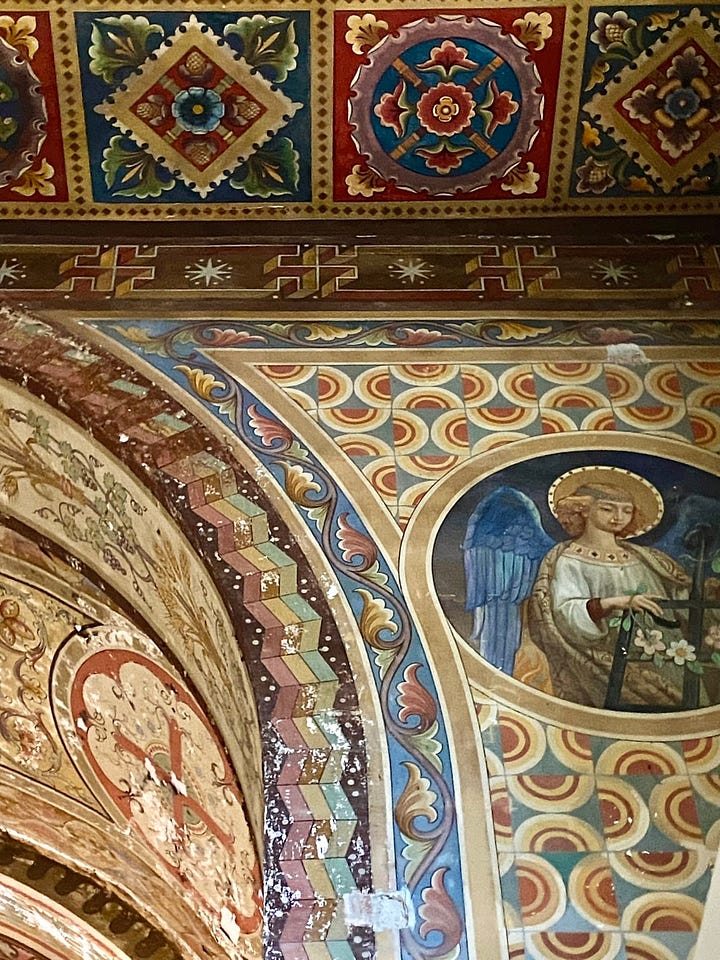
One bare wall is projected floor to ceiling with cinematic digital renderings of the architecture ticking through the centuries, unpicked from the scramble of stone and bone. Charcoal illustrations of the major players sail by.
Centuries of pagan burials on this flood-free right bank of the Isère. Celtic warriors resisting the Romans and failing. Elite Gallo-Romans building and venerating their mausoleums. Horned-helmeted Franks marauding. The baptism of Clovis, Roi des Francs. The advent of Charlemagne and a grander Carolingian church superimposing the first medieval funeral chapel. The bishop of Grenoble gifting it, in disrepair, to 11th-century Benedictine monks. Archbishops and dauphins visiting an even greater, cloistered church. Chaos and pillage of 16th-century wars of religion. The bisection of new city fortifications. Gentleman-scholars’ archaeological interventions. Uncovering of graves by a 20th-century female-led dig (la fouille).
Now: museum of the dead.
Where the cloister once was, the necropolis is laid bare. Open graves look up at the sky from beneath glass and steel; only one narrow grave is armored with ceramic tiles. A skeleton with a broken skull looks small enough to be a child; an even smaller child was interred in an amphora. In the walls of the dig, tree roots snake dustily through the bone-packed dirt.
Some of the skeletons have their own interpretive archaeological shrines describing the irregularities of their bones and the signs of their lives. One old man had disintegrating vertebrae that would have doubled him over, and he must have lived on the care of his community. Another man with dire dental problems had a hole drilled in the top of his skull some weeks before he died. Trepanning?
An especially robust and Germanic skeleton under the glass in the dim nave, reflected luridly in the walkway partition, might have been the first prior of the 11th-century Benedictine priory, old Prieur Guy.
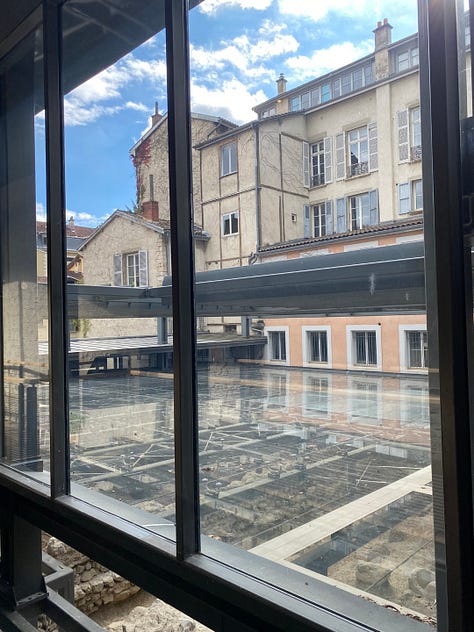



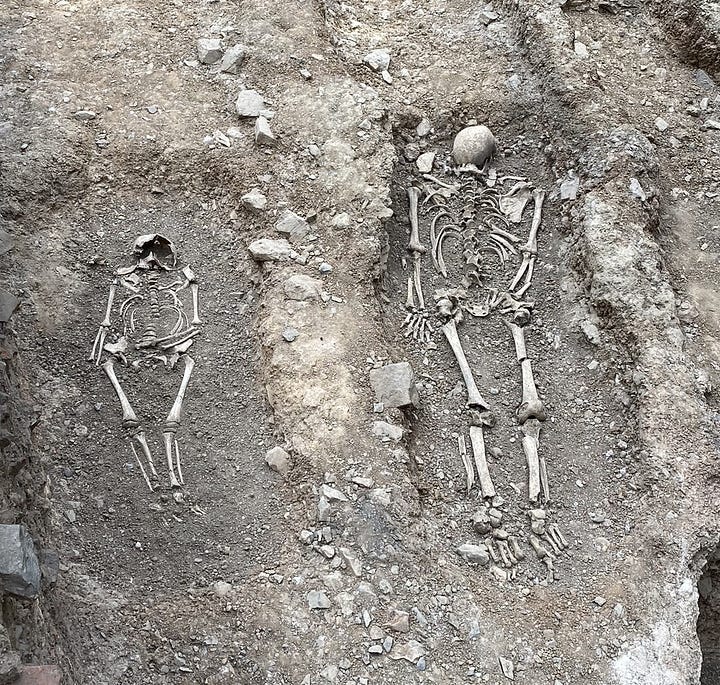
In the necropolis, there is a yawning black opening with narrow stone steps plunging down. Tight against its outer wall lies a well-preserved skeleton, collapsed skull turned to one side toward the chamber, arms crossed. The mausoleum within is not open to the public for preservation reasons3, but there is a vibrantly painted model of the Roman interior on display, with almost psychedelic wall décor. I long to go inside.
With so many graves layered from the earliest centuries of the first millennium to the year 1800, the anthropological appeal of the dig is clear: a longitudinal study of funerary rites and burial practices. So there are funerary bits and bobs on display from across the centuries; a bone-toothed comb; beads; crosses; Roman and medieval coins originating from around France.
There are also strange little works of sculptural textile art stashed around the site: a woven demon perched on a ledge above an open grave; garlands of pink shapes a little too much like entrails strewn over the stairs into the burial chamber.4
In a corridor there is a shelf lined with carved heads with leering stone faces that were once the capitals of columns.
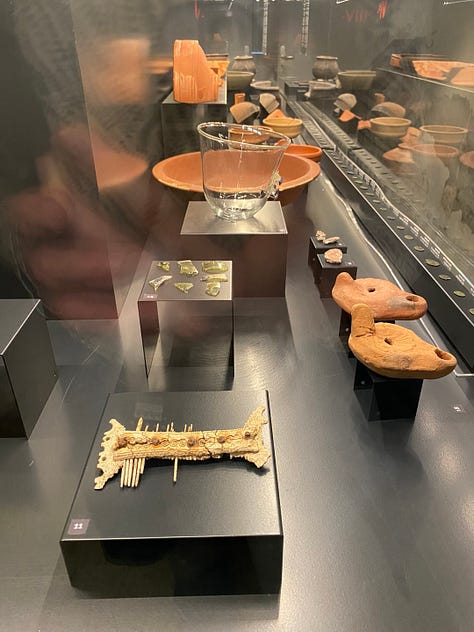
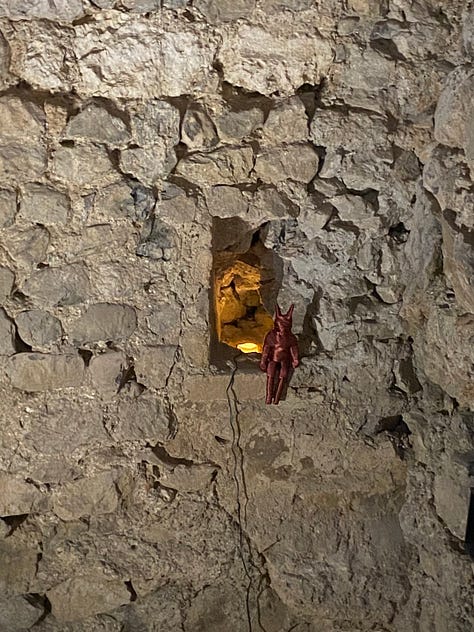

Around the corner is an empty chamber with an arched ceiling striped with seams of terra cotta, colonnaded with worn fluted columns with capitals of birds and plants. At one end, an alcove where something like a rough-hewn altar stands. This is the 5th-century Crypte Saint-Oyand5, jewel of the site, first relic to be recognized and restored. I think the audio guide said it was where processionals passed through before burial, pondering the symbolism of birds with stalks of wheat in their beaks. It’s a silent, suggestible room.

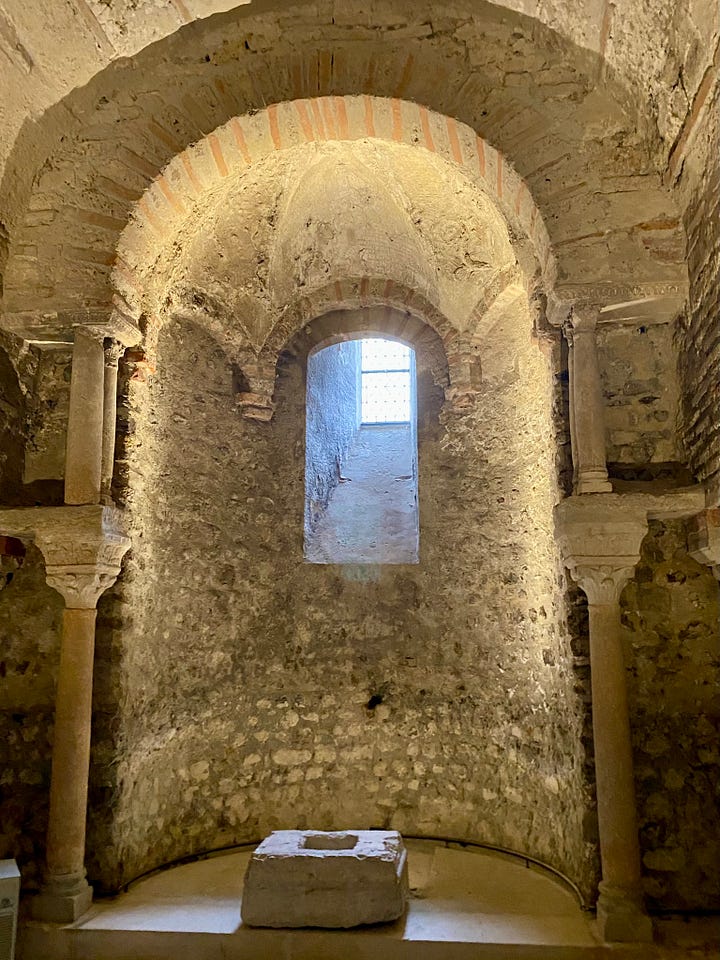


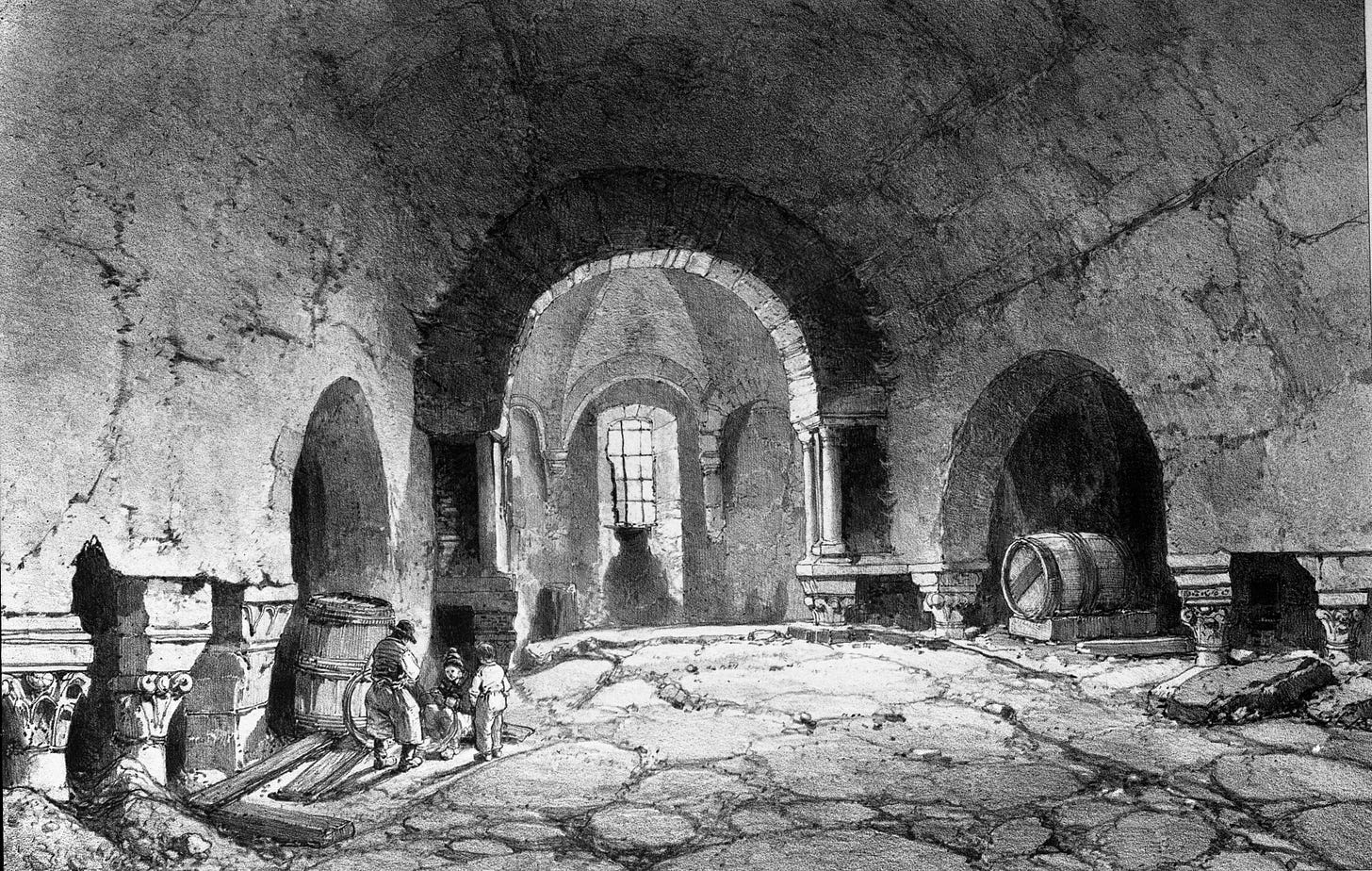

We re-ascend from the crypt via the warped stone spiral staircase of the bell tower.
Just outside the museum door, the switchbacks up to the mountain fort begin, swathed in bushes and vines. The old wall is draped with succulents.
Behind us, the daylight rests over the bones.
P.S. If you’d like some more Halloweeny reading, below I recommend two ghostly past posts to revisit. Also check out
for some perfectly macabre literary and historical scraps.Ways in: Fort des Quatre Seigneurs
It’s All Saint’s Day. The sky is a moody gray and the trees are restless. You’ve just made the ascent, steep and slick with leaves, to the wooded hilltop that was once a crossroads of four ancient fiefdoms. You’ve come to see the fort. The abandoned one.
A graveyard in England is rife with life. Even in October the graveyard is green.
Fun fact, the French convention for writing century names is Roman numerals plus the numerical suffix, e.g. VIème or VIe siècle for 6th (sixième) century. Reading museum plaques in French is already hard enough… (Another fun fact, this museum actually had very few plaques and relied on the audio guide and projections.)
I can’t really say if the wall painting is a true example of Art Nouveau; given the apparent date of 1910 (according to Wikipedia) and the penchant for elaborate patterns, it seems possible, but it doesn’t quite fit my layperson’s idea of Art Nouveau style. If anyone more expert in decorative arts has an opinion, do tell!
Ostensibly ;)
The artist’s installations used to be more extensive, but I preferred the unobtrusive remnants.
If you want to know more about the Saint-Oyand crypt, here is some Google-translated text from this website:
“At the beginning of the 6th century, a cruciform funeral church was attached to the mausoleum. Remodeled and embellished in the 7th century, this church was replaced in its upper parts by a vast church in the Carolingian era, which itself gave way to the current Saint-Laurent church. But the crypt of the funeral church, dedicated to Saint Oyand, has been preserved to this day and is undeniably the jewel of the site. Built at the beginning of the 6th century, it was decorated in the following century with a colonnade comprising twenty columns made of Vimine breccia, Bourdeaux conglomerate or white Savoy marble, reused from the ancient period. The columns are topped with capitals and abacuses in Baux-de-Provence limestone or white marble, with a remarkable and rich sculpted decoration, characteristic of 7th century Christian iconography: palm trees, date palms, lambs, doves, griffins and canthares. The Saint-Oyand crypt was restored in the 19th century by the architect Manguin. Thanks to the great interest shown in it by Prosper Mérimée, the request for the crypt to be classified was granted in 1850. The name Saint-Oyand refers to a monk from the Jura, Eugendus, abbot of the Condat abbey who enjoyed a certain veneration in the region during the Merovingian era.”




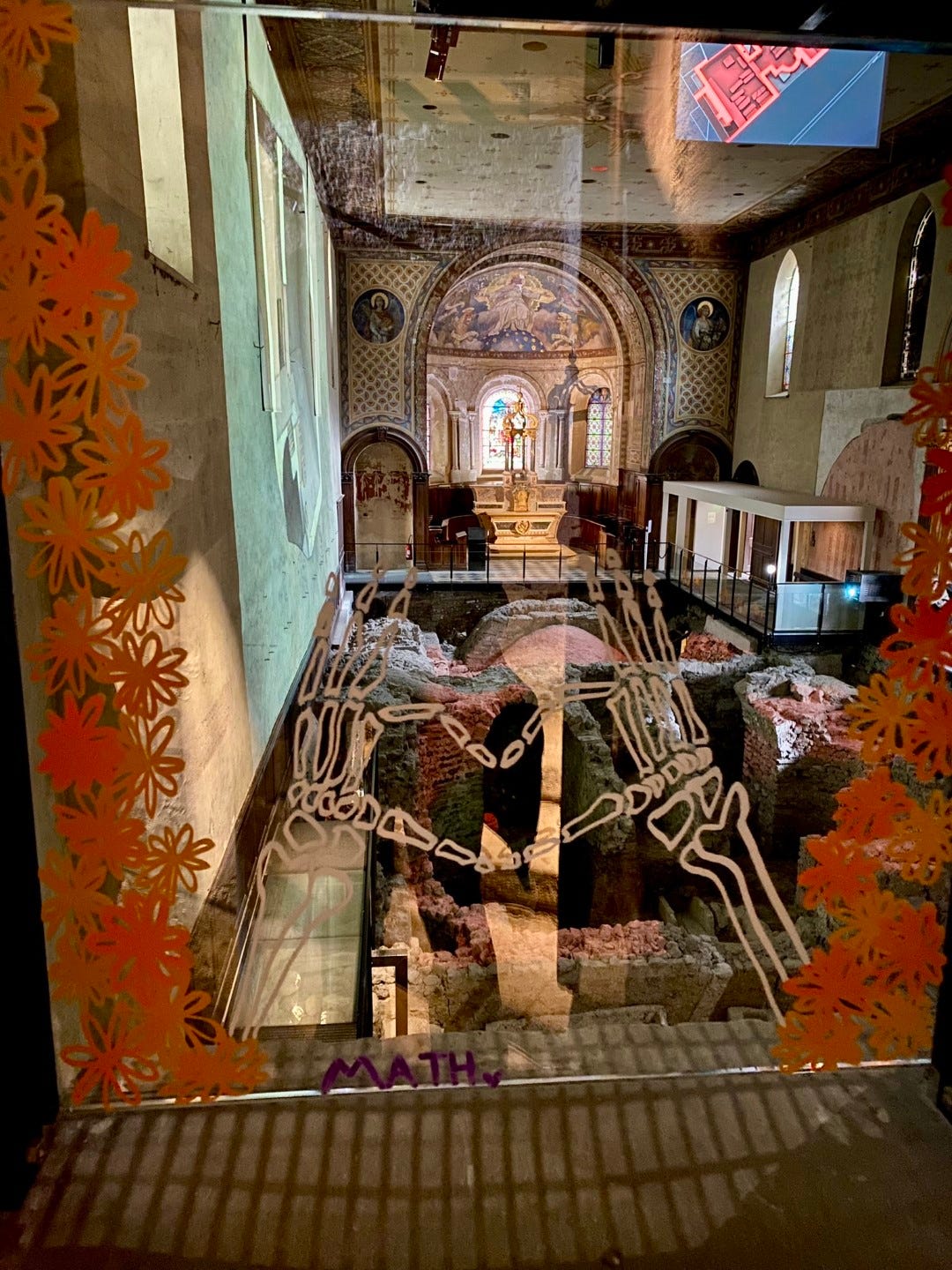



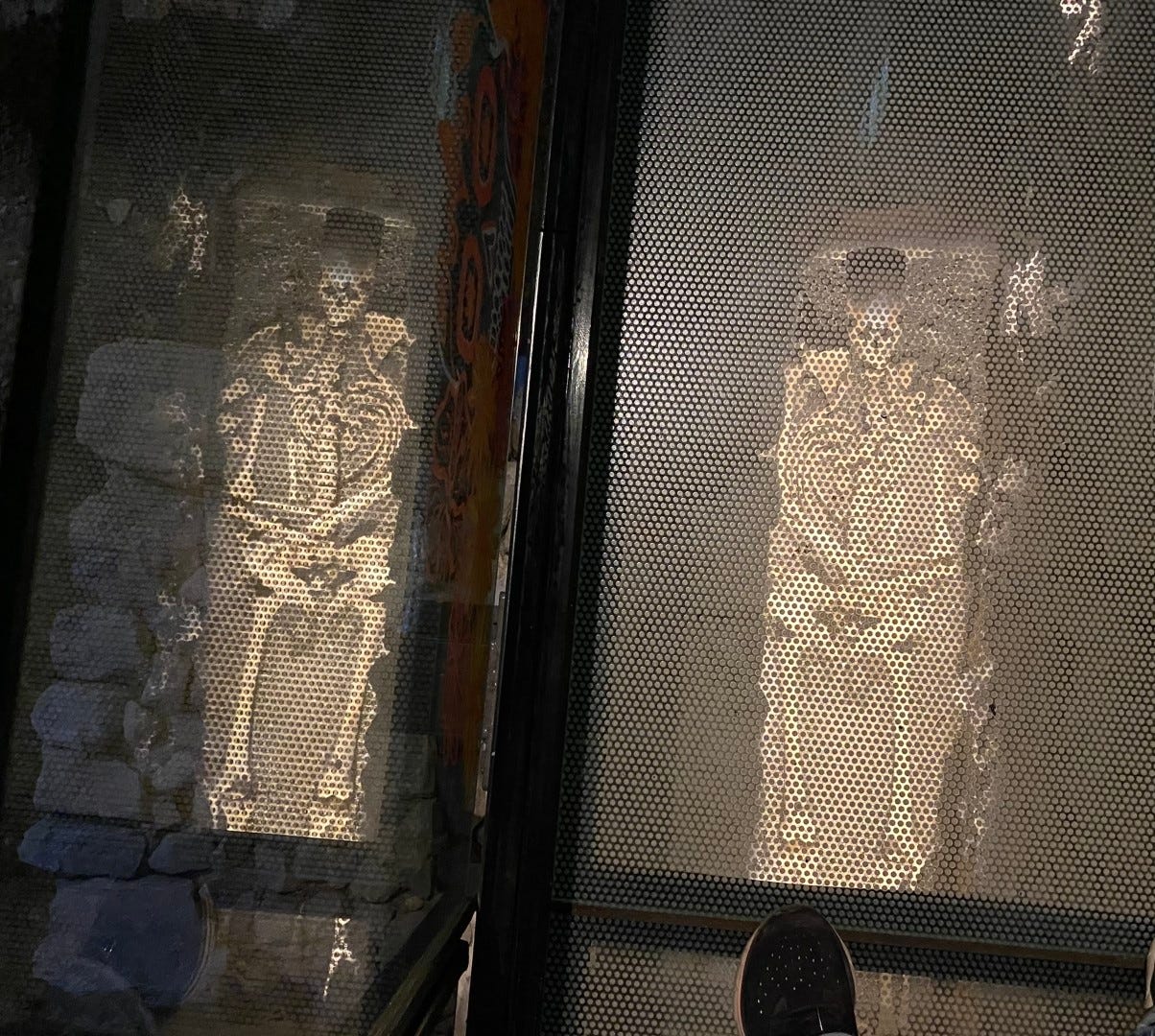
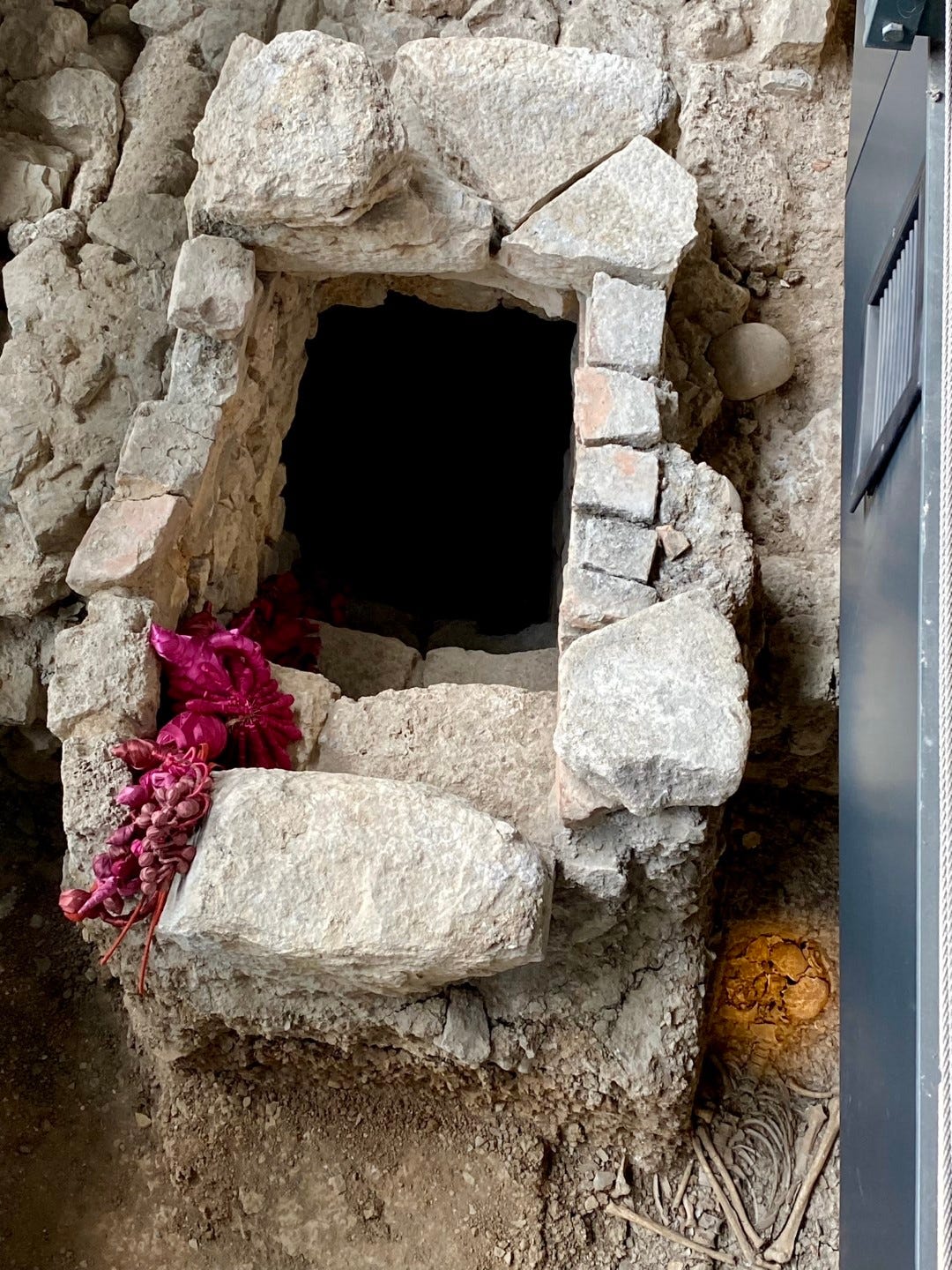





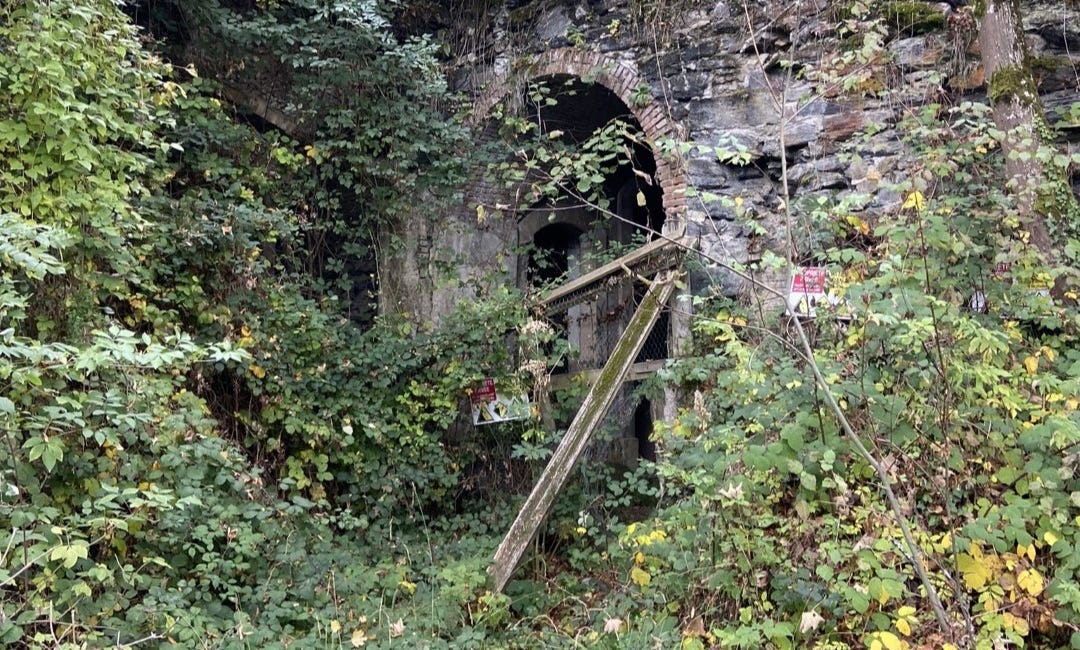
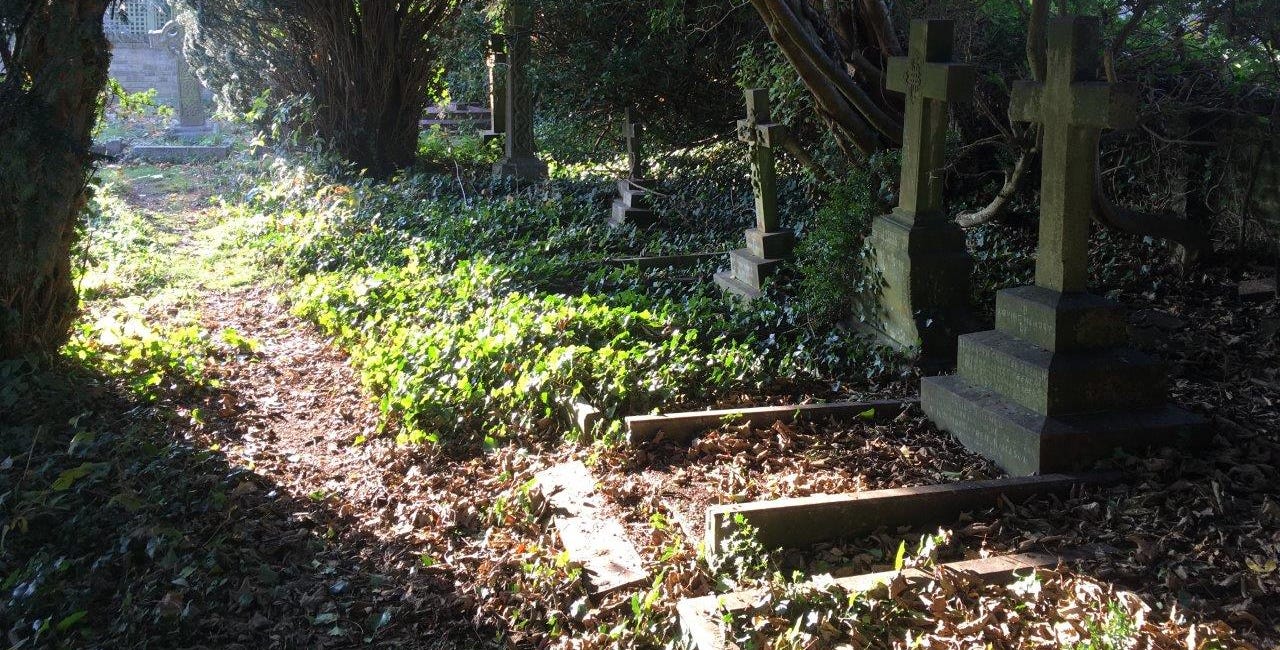

That site does look fascinating, and a bit quirky too. It's not surprising I missed this post -- I had just gotten back from the USA. A whole week of newsletters went unopened. Thanks for guiding me back to it!
What a fabulous place! I'd love to see it.